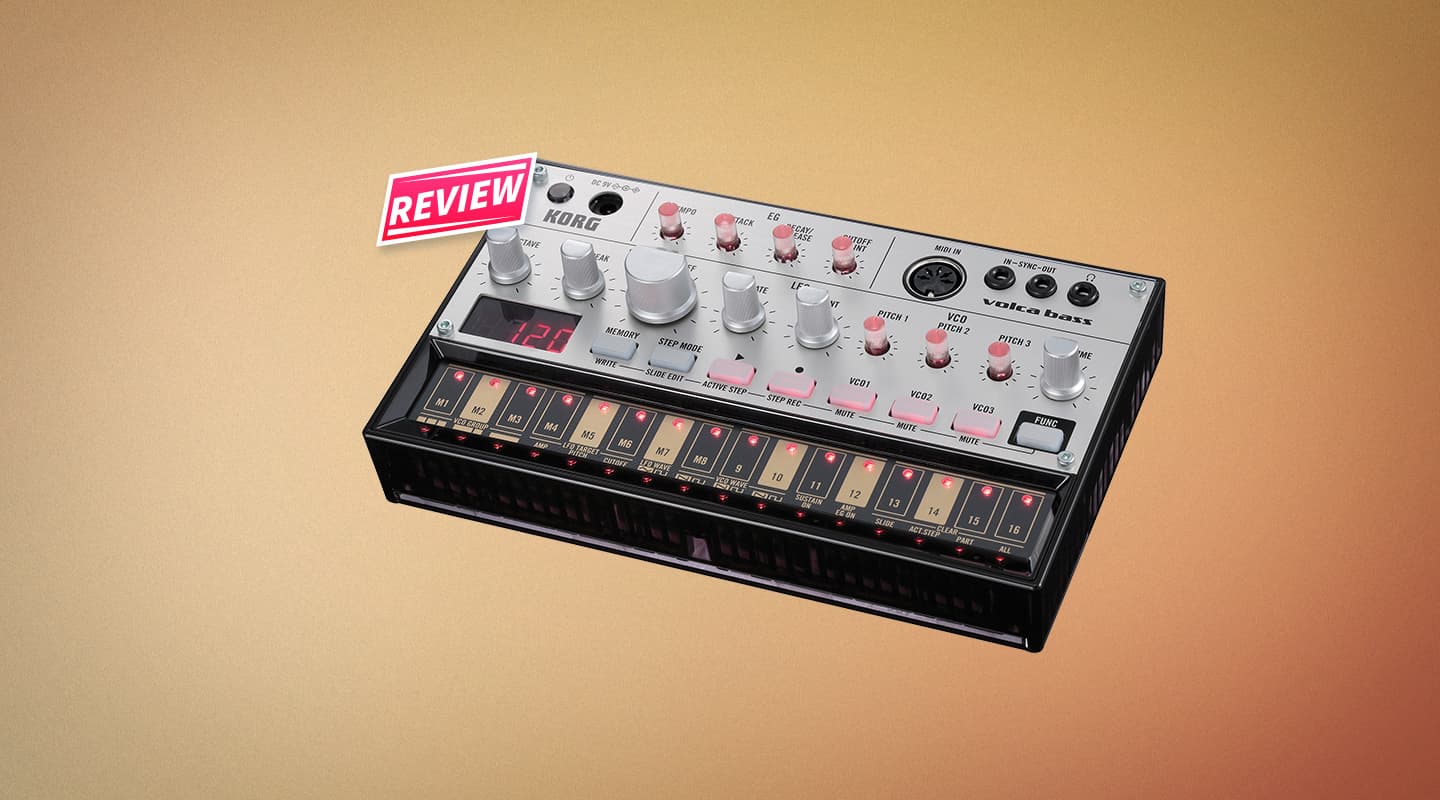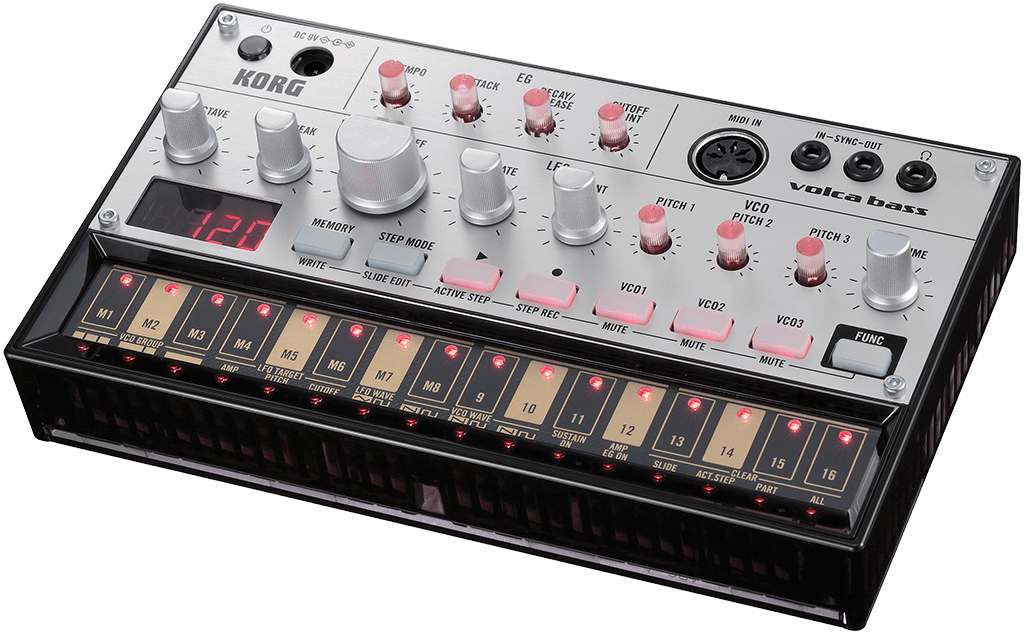
Review: Korg Volca Series
Three analogue pocket synths destined for classic status.
Everybody in electronica world is acutely aware of the superiority of analogue synthesis over digital waveform generation. While the 1990s saw the proliferation of countless analogue recreations and approximations using sampled and digitally produced oscillators for synthetic instruments, when the dust settled there was really no substitute for voltage controlled oscillators and filters — they just sound better. Granted, more recent technologies such as digital sampling and virtual modelling are indispensable tools, but when it comes to twerp, tweak and thwomp, the good old VCO and VCF combination win the day.
Korg is one company prepared to acknowledge this fact, and has brought a number of purely analogue synthesis machines to the market in recent years. Starting with the diminutive Monotron, a pocket-sized analogue synth with filters derived from the late ’70s MS-20, and more recently, the utterly brilliant reincarnation of the MS-20 itself [see Issue 95]. Korg knows just the right buttons to push.
Hot on the heels of the recently reviewed MS-20 Mini is the Volca range of analogue synth/sequencers. The trio consists of Volca Bass: a TB303-style, three-voice bass synth and sequencer; Volca Beats: an analogue drum machine and rhythm sequencer referencing all the usual drum machine suspects; and Volca Keys: a three-note synth with sequencer.
VOLCA BASS
Stand aside TB-303. Nobody in their right mind would shell out two grand (plus) for Roland’s seminal ‘Bassline’. Well, maybe some would, but why with the Volca Bass on offer? It’s far more capable, much more reliable, and way cheaper. For a start there’s an LFO assignable to amplitude, pitch, filter, or any combination of the three mod destinations. You’ve also got three voices to mingle, each of which can be saw or square waveforms. Each voice is mutable and has individual pitch control via a backlit pot. The backlighting designates which voice you’re editing with the knobs, then which are grouped to have all three voices play from a single sequence pattern. Ungrouping them will allow three different sequences play each of the three separate voices. Combined with the three voice mute buttons, it’s pretty easy to build up a set of sequences, or build up and break down a sound throughout a composition.
While on the subject of sequences: recording can be either step or ‘active-step’ with 16 steps per sequence. Step sequencing is simply activating chosen segments of the ribbon strip keyboard such that the LED below each step is lit. Then hit play and you’re off. In this mode it’s also possible to add slide between steps. Active-step plays the sequence while you turn steps on or off, hearing the changes in the context of the sequence. You’ll have to back bump into step mode to add slide events. Now for the bad news: there are eight memory locations for sequences and no method of saving them out to an external device. Cue the MIDI input and an external sequencer.
And how’s it sound? Well, remarkably like a TB-303 actually. The 12dB/oct filter helps with this (adjusted with the biggest knob on the top panel), as does the square/saw waveform choice. And to quote the manual: “… allows you to create hard acid house sounds with tones similar to those of a bass guitar.” It’s got 303 written all over it!
NEED TO KNOW
Korg Volca Series
Analogue Mini-Synths
VOLCA BEATS
Possibly the cutest drum machine I’ve ever had the pleasure of meeting, the Volca Beats offers 10 drum sounds: kick, snare, low and high tom, open and closed hat, clap, claves, agogo, and crash cymbal. These sounds are a combination of both analogue and PCM waveform (aka ‘sampled’) drum sounds. Four sets of pots provide control over six of these sounds, with the four sets separated into kick, snare, tom, and hat. Kick editing includes decay, pitch and click; Snare includes decay, pitch and ‘Snappy’ (an undeniable nod to the Roland TR808); Tom includes overall decay and separate pitch control for the low and high toms; Hat includes decay for each of the open and closed hat sounds, and ‘grain’, which lengthens the open hat sound while lowering the pitch. A final control pot alters ‘PCM Speed’. In other words, slowing down the playback speed of any PCM waveforms used. These sounds include the crash, clap, clave, and agogo.
What’s interesting about the PCM sounds is how you can alter the PCM Speed individually for each PCM generated sound and this information will save as part of a rhythm sequence opening an array of creative possibilities (the clap slowed all the way down is excellent). The remaining analogue sounds always reflect the positions of the analogue edit pots, as you’d expect, regardless of which sequence is playing. Each drum sound’s level can be altered via a single ‘Part Level’ control — you select the part (drum sound) with the left/right part buttons until the desired part shows an LED below the ribbon controller at its part position, then adjust accordingly. Unlike the PCM Speed control, this alters part volume globally across all rhythm sequences.
Another excellent trick is the ‘Stutter’ effect. This is a really basic delay effect offering time and depth controls, yet you can do some great things with it. Using what Korg describe as ‘Motion Recording’ you can apply delay effects to any of the drum parts individually — even the changes you make to the Stutter control knobs are recorded. Equally as cool is the ability to ‘Motion Record’ PCM Speed changes for any of the four PCM-based sounds. This will be saved into the sequence data. It’s grouse! How many sequences can you save? Like the Volca Bass, a mere eight memory slots are provided. I really wish there were 16.
Korg knows just the right buttons to push



VOLCA KEYS
Possibly the most original of the trio is Volca Keys. This is a basic three-voice analogue synth with three VCOs, a VCF, one VCA, an LFO to modulate either amplitude, pitch, or filter cutoff, and an envelope generator capable of modulating both the filter and the VCO. LFO shapes include sawtooth, triangle, square. It really doesn’t get much simpler. There are six options for configuring the oscillators: Poly, where up to three saw wave notes can be played at once; Unison, for combining three saw wave voices into a single voice at the same pitch; Octave, where the oscillator creates two saw wave notes an octave apart; Fifth, similar to Octave but, you guessed it, a fifth interval; Unison Ring, where all three voices produce a ring modulated square wave; and Poly Ring, up to three notes of ring modulated square wave. So, as you can surmise, this machine is squarely aimed at the bleeps, boings and squarks brigade. Hell, there’s even a delay thrown in to make those LFO and filter sweeps stand out even more. Psychotic! This can be synced to the current tempo or left in freeform mode. Like Volca Beats, the Volca Keys includes a motion recording mode allowing recording of all the synths parameter knobs. This is possibly the most powerful side of the Volca Keys as you can really go to town with several parameters, adding modulation by hand that couldn’t be achieved with the basic synthesis modulation sources. A final sound-sculpting tool specifies which octave the notes play at. Be warned: this knob only affects notes you’re playing into a sequence. Once a sequence is committed to a memory that sequence will remain at that octave. And again: there are eight sequence memories.
I can’t help but think the Volca Keys would be last on my list should I buy all three, but that doesn’t detract from what a cool little synth it can be. Like many, I’m sure I’d have something laying around to take on the more melodic sections of an analogue composition. But then again, it’d just be great to complete the set. If you know what I mean.
MÉNAGE À TROIS
I’ve really got to dip my lid to Korg yet again. If you’re after acid squelch machines that are both reliable and extremely creative, look no further. Yet, I feel the three little Volcas simply don’t deserve separation. It’s just so much fun syncing them all up and having a blast. They’re small enough to stash in a backpack. They run on batteries. They sync with most things that will put out a beat, they’re real analogue synths, and, they’re so cheap they’re simply begging to be purchased as a group. Perhaps if you’ve already invested in Korg’s Electribe units you could happily do without Volca Keys. But otherwise, grab the trio. One final interesting point is how these units are ripe for modification, and already you can find a number of mods on the web for additional audio outputs and even a MIDI output. Destined to become classics.
















RESPONSES